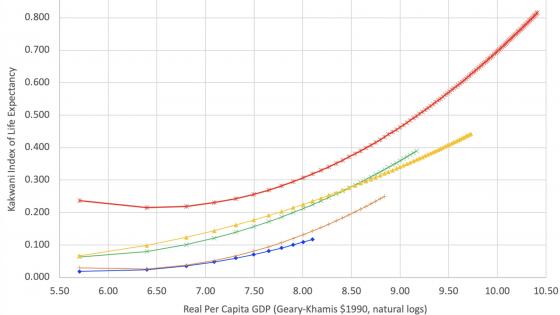Human wellbeing is increasingly viewed as a multidimensional phenomenon, of which income is only one facet (Stiglitz et al. 2009, OECD 2011, Proto and Rustichini 2014). However, economists continue to rely on GDP to gauge wellbeing (Oulton 2012). A way to assess GDP as a comprehensive measure of wellbeing is by looking beyond per capita income. In a recent paper, I focus on life expectancy at birth – a synthetic measure of health – and its relationship with per capita income over the past 150 years (Prados de la Escosura 2022).
An important caveat is that, when assessing life expectancy over time and across countries, we need to bear in mind that original values of life expectancy are bounded and that life quality improves with the quantity of years lived (Prados de la Escosura 2021). A solution is provided by Kakwani’s (1993) non-linear transformation in which an increase in life expectancy at birth at a higher level implies a greater achievement than would have been the case had it occurred at a lower level.
Trends in life expectancy and per capita income
Life expectancy (expressed as a Kakwani index) exhibits slightly faster long-run growth than per capita GDP. A closer look, however, reveals an apparent development puzzle: economic growth and life expectancy gains do not match each other (Table 1). During the globalisation backlash between 1914 and 1950, real per capita GDP growth slowed down as world commodity and factor markets disintegrated, while life expectancy experienced major gains across the board. But, from 1950 onwards, life expectancy achieved, on average, smaller gains to GDP per head. Thus, world average life expectancy exhibited a major advance across the board before 1950, earlier than usually presumed and at odds with the view that that global health only improved after WWII, when new drugs from the West reached the rest of the world (Acemoglu and Johnson 2007, Klasing and Milionis 2020).
Table 1 Trends in life expectancy and real per capita GDP
Notes: Kakwani Index (growth rates %)
Sources: Foundation Rafael del Pino
Moreover, the evolution of life expectancy and per capita income’s international distribution is at odds. Life expectancy inequality rose from 1870 to the mid-1920s, fell until the early 1980s, and experienced a partial rebound over 1990–2010. In the case of per capita income, inequality rose up to the mid-1970s, stabilised, and then declined sharply since 1990.
Figure 1 International inequality in life expectancy and real per capita income, 1870-2015
Notes: Kakwani Index, population-weighted mean log deviation (MLD)
The annual cumulative growth rate by percentiles, from bottom to top (the growth incidence curve) also shows differences. In the case of life expectancy, the middle of the distribution experienced the main relative gains in the long run, followed by the lower-middle ventiles, and the smallest gains accrued to those at the top (Figure 2). As for per capita income, the bottom ventile achieved the lowest relative gains while the middle and the top of the distribution experienced the main relative gains
Figure 2 Growth incidence curves for life expectancy and real per capita income, 1870-2015 (%)
Source: Kakwani Index. See the text for further details.
Accounting for life expectancy’s distinctive behaviour
What explains the different pace and breadth of life expectancy gains? It is commonly assumed that economic progress largely does. By raising average incomes, modern economic growth facilitates better nutrition, which strengthens the immune system and reduces morbidity (McKeown 1976, Fogel 2004). The increase in the public provision of health is another effect of higher average incomes (Loudon 2000, Cutler and Miller 2005). However, health improved across the board during the past 100 years, including in countries in which social spending did not expand and during phases of sluggish economic growth (Riley 2001, Sunde and Cervellati 2012).
Samuel Preston (1975) investigated the connections between life expectancy at birth and per capita GDP and concluded that increases in per capita income only explained a minor proportion of the rise in the lifespan, which was mainly attributable to the diffusion of medical advances resulting from the empirical validation of the germ theory of disease.
I tested Preston’s association for a sample of 112 countries over 1870-2015, but instead of the original values, I used the Kakwani index of life expectancy and the natural logarithm of real per capita GDP at different cross-sections. The resulting relationship is convex, rather than concave as Preston observed. This suggests that advances in medical knowledge led to more-than-proportional gains in health as income rose. Moreover, the exercise confirms the existence of sustained outward shifts in the relationship over time, as put forward by Preston. Figure 3 shows a clear outward shift over time, but it does not proceed at the same pace between each pair of cross-sections. Thus, intense outward shifts between 1913 and 1950 and between 1970 and 2015 contrast with mild ones during 1870-1913 and 1950-1970.
Figure 3 Revisited Preston curve, 1870-2015
Over the past one and a half centuries, economic growth and medical advances appear to have contributed alike to longevity gains, but their contributions vary over time. Modern economic growth accounted for over 60% of the increase in the Kakwani index of life expectancy over 1870-1913 and, again, during the last period, 1970-2015. However, during the first half of the 20th century, three-fourths of the Kakwani index gains accrued to advances in medical knowledge. This finding matches Preston’s lower bound estimates. Conversely, during the Golden Age (1950-1970) the increase in per capita income accounted for the entire improvement in the Kakwani index of life expectancy.
Discussion
Life expectancy improvements can be depicted in terms of a health function (Easterlin 1999). Movements along the function represent gains attributable to economic growth and outward shifts of the health function result from improvements in medical knowledge. The strong outward shift in the health function during the first half of the 20th century arose from the diffusion of epidemiological transition. Triggered by the germ theory of disease, the epidemiological transition initiated in western Europe in the late 19th century and only started spreading worldwide from the 1920s (Riley 2001). Persistent gains in lower mortality and higher survival rates were achieved as infectious disease gave way to chronic disease as a major cause of death (Omran 1971). Two main consequences resulted from the diffusion of the germ theory of disease. On the one hand, medical technological progress resulted in new drugs to cure infectious diseases and spread the health transition (Easterlin 1999, Jayachandran et al. 2010, Lindgren 2016). On the other hand, and most decisively, low-cost improvements in public health derived from the diffusion of preventive methods of disease transmission and knowledge dissemination often through school education. This second channel of diffusion helps explain why the epidemiological transition spread in developing countries since the early 20th century, despite the fact that many of them were still under colonial rule and the new drugs were largely unaffordable.
Another significant outward shift of the health function took place in the late 20th century. This was the outcome of what may be depicted as a second health transition in which mortality and morbidity fall among the elderly as a result of new medical knowledge that allows better treatment of respiratory and cardiovascular disease (Cutler et al. 2006, Chernew et al. 2016, Eggleston and Fuchs 2012).
The substantial increases in longevity during the epidemiological transition were unevenly distributed throughout the world. Lack of economic means and basic scientific knowledge prevented a fast and wide diffusion of new medical technology and health practice across countries. In the late 19th and early 20th centuries, the increase in life expectancy inequality was due to the fact that the first health transition was initially restricted to advanced western countries. The gradual international diffusion of the health transition favoured the reduction in life expectancy inequality between the late 1920s and 1980. By 1970 the diffusion of the epidemiological transition was largely exhausted. The second health transition has been restricted so far to advanced countries due to its higher cost and this helps explain why inequality rebounded at the turn of the century.
Concluding remarks
Unlike the conventional wisdom, life expectancy at birth and real per capita GDP behaved differently in terms of trends and distribution during the past 150 years. Long-run improvements in life expectancy depended on advances of medical knowledge as much as on economic growth that facilitated better nutrition and the provision of health services. Thus, focusing only on movements along the health function, which derive from increases in average incomes, ignores the important shifts in the function that are closely connected to the diffusion of new medical knowledge.
References
Acemoglu, D and S Johnson (2007), “Disease and Development: The Effects of Life Expectancy on Economic Growth”, Journal of Political Economy 115: 925-985.
Chernew, M, D M Cutler, K Gosh and M B Landrum (2016), “Understanding the Improvement in Disability Free Life Expectancy in the U.S. Elderly Population”, NBER Working Paper 22306.
Cutler, D and G Miller (2005), “The role of public health improvements in health advance: The twentieth century United States”, Demography 42(1): 1-22.
Cutler, D M, A Deaton and A Lleras-Muney (2006), “The Determinants of Mortality”, Journal of Economic Perspectives 20: 97-120.
Easterlin, R (1999), “How Beneficient is the Market? A Look at the Modern History of Mortality”, European Review of Economic History 3(3): 257-294.
Eggleston, K N and V Fuchs (2012), “The New Demographic Transition: Most Gains in Life Expectancy Now Realized Late in Life”, Journal of Economic Perspectives 26: 137-156.
Fogel, R W (2004), The Escape from Hunger and Premature Death, 1700–2010. Europe, American and the Third World, New York: Cambridge University Press.
Jayachandran, S, A Lleras-Muney and K V Smith (2010), “Modern Medicine and the Twentieth Century Decline in Mortality: Evidence on the Impact of Sulfa Drugs”, American Economic Journal: Applied Economics 2: 118-146.
Kakwani, N (1993), “Performance in Living Standards. An International Comparison”, Journal of Development Economics 41: 307-336.
Klasing, M J and P Milionis (2020), “The International Epidemiological Transition and the Education Gender Gap”, Journal of Economic Growth 25: 37–86.
Lindgren, B (2016), “The Rise in Life Expectancy, Health Trends among the Elderly, and the Demand for Care. A Selected Literature Review”, NBER Working Paper 22521.
Loudon, I (2000), “Maternal Mortality in the Past and its Relevance to Developing Countries Today”, American Journal of Clinical Nutrition 72(1) (supplement): 241S-246S.
McKeown, T (1976), The Modern Rise of Population, New York: Academic Press.
OECD (2011), How’s Life. Measuring Wellbeing, Paris: OECD Publishing.
Omran, A R (1971), “The Epidemiological Transition: A Theory of Epidemiology of Population Change”, Milbank Memorial Fund Quarterly 49(4): 509-538.
Oulton, N (2012), “Hooray for GDP! GDP as a measure of wellbeing”, VoxEU.org, 22 December.
Prados de la Escosura, L (2021), “Augmented Human Development in the Age of Globalisation”, Economic History Review 74(4): 946-975.
Prados de la Escosura, L (2022), “Health, Income, and the Preston Curve: A Long View”, CEPR Discussion Paper 17151.
Preston, S H (1975), “The Changing Relationship between Mortality and the Level of Economic Development”, Population Studies 29(2): 231-248.
Proto, E and A Rustichini (2014), “GDP and life satisfaction: New evidence”, VoxEU.org, 11 January.
Riley, J C (2001), Rising Life Expectancy. A Global History, New York: Cambridge University Press.
Stiglitz, J E, A Sen, and J P Fitoussi (2009), Report by the Commission on the Measurement of Economic Performance and Social Progress.
Sunde, U and M Cervellati (2012), “Diseases and development: Does life expectancy increase income growth?”, VoxEU.org, 6 January.






